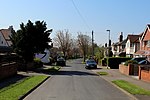Battle of Seacroft Moor
1643 in England17th century in YorkshireBattles involving YorkshireBattles of the English Civil WarsConflicts in 1643 ... and 4 more
History of LeedsMilitary history of West YorkshireSeacroftUse British English from March 2012
The Battle of Seacroft Moor took place in Whinmoor moor near the village of Seacroft, north-east of Leeds in West Riding on 30 March 1643 during the First English Civil War. In the battle, a Parliamentarian force commanded by Lieutenant-General Thomas Fairfax was decisively beaten by a Royalist cavalry force commanded by George Goring.
Excerpt from the Wikipedia article Battle of Seacroft Moor (License: CC BY-SA 3.0, Authors).Battle of Seacroft Moor
York Road, Leeds Barwick in Elmet and Scholes
Geographical coordinates (GPS) Address Nearby Places Show on map
Geographical coordinates (GPS)
| Latitude | Longitude |
|---|---|
| N 53.85 ° | E -1.4 ° |
Address
York Road Kiddal Hill Farm
York Road
LS14 3AE Leeds, Barwick in Elmet and Scholes
England, United Kingdom
Open on Google Maps











